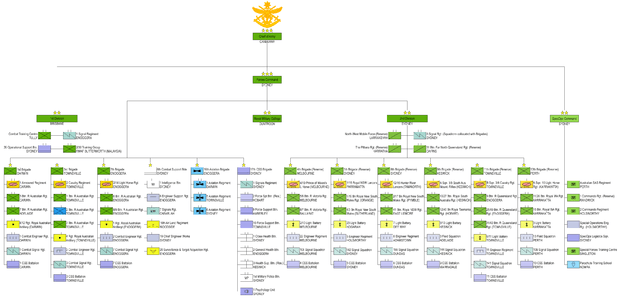Plan Beersheba

Plan Beersheba is a significant restructure of the Australian Army which was announced in 2011.[1] The process of implementing the organisational changes began in 2014, and they are scheduled to be completed in 2017.[2]
Changes to the regular Army
Under Plan Beersheba, the Army's three regular force combat brigades (the 1st, 3rd and 7th Brigades) will be restructured into multi-role formations with a similar structure;[1] before this time the brigades were structured as mechanised, light infantry and motorised infantry formations respectively.
Each of the multi-role brigades will comprise:[2]
- Brigade headquarters
- One armoured cavalry regiment (each equipped with M1A1 tanks, ASLAV light armoured vehicles, and M113 armoured personnel carriers).[3]
- Two light infantry battalions
- One artillery regiment
- One combat engineer regiment
- One combat signals regiment
- One Combat Service Support Battalion
It is intended that the three brigades will rotate through a 36-month-long readiness cycle, comprising three 12 month phases. These will comprise a 'reset' phase during which the brigade's soldiers conduct individual training, a 'readying' phase in which the brigade's units will prepare for combat operations, and a 'ready' phase in which the brigade will be available to deploy.[4]
The 2nd Battalion, Royal Australian Regiment will specialise in amphibious warfare.[4]
The three combat brigades will continue to be supported by the specialist 6th, 16th and 17th Brigades.[5]
Changes to the Army Reserve

Australian Army Reserve units will also be significantly restructured. As part of the changes, the Army states that the reserves' role will become "to deliver specified capability and support and sustain Australian Defence Force (ADF) preparedness and operations".[6]
The six reserve brigades in the Army's 2nd Division have also been assigned a new role. Two army reserve brigades will be paired with each of the regular brigades.[6] The 4th and 9th Brigades will partner with the 1st Brigade, the 5th and 8th Brigades with the 7th Brigade, and the 11th and 13th Brigades with the 3rd Brigade.[7] The pairs of brigades will be expected to be able to provide a battalion-sized force upon mobilisation during the regular brigade's 12 month 'ready' phase.[6]
The structure of the reserve brigades will also be changed. The reserve artillery regiments will be re-equipped with mortars; the reserve Royal Australian Armoured Corps units will convert from light cavalry to producing crews for Bushmaster Protected Mobility Vehicles, and a brigade operational supply company will be established within each of the combat services support battalions.[6]
References
- 1 2 "Defence announces major Army restructure". ABC News. 12 December 2011. Retrieved 16 August 2015.
- 1 2 "Multi-role Combat Brigades". Australian Army. Retrieved 16 August 2015.
- ↑ Bickell, Craig (2013). "Plan Beersheba: The Combined Arms Imperative Behind the Reorganisation of the Army" (PDF). Australian Army Journal. Canberra, Australian Capital Territory: Land Warfare Studies Centre. X (4): 39. ISSN 1448-2843.
- 1 2 "Plan BEERSHEBA". Australian Army. Retrieved 16 August 2015.
- ↑ "Prime Minister and Minister for Defence – 2013 Defence White Paper: 'Plan BEERSHEBA' – Restructuring the Australian Army". Media release. Julia Gillard and Stephen Smith.
- 1 2 3 4 "Reserves". Australian Army. Retrieved 16 August 2015.
- ↑ Clay, Peter (June 2014). "The Australian Army's 2nd Division: An Update" (PDF). United Service. Royal United Services Institute of New South Wales. 65 (2): 29.